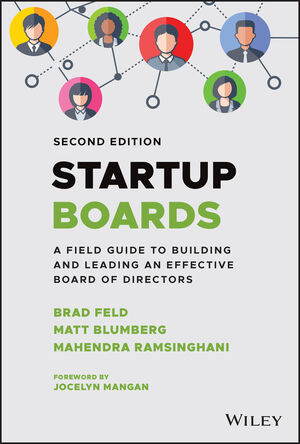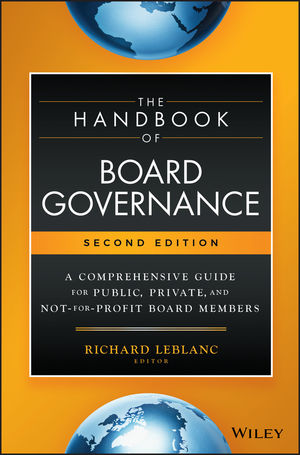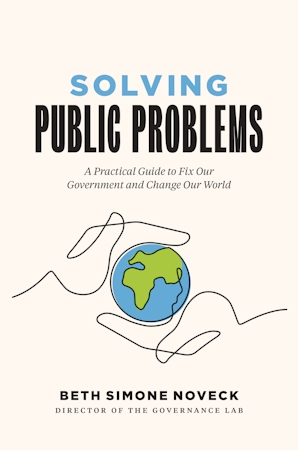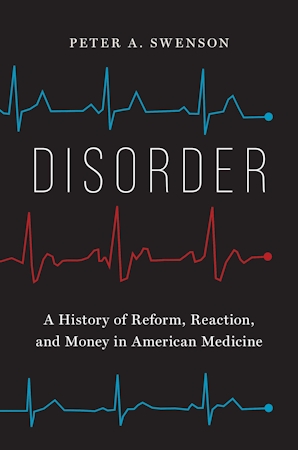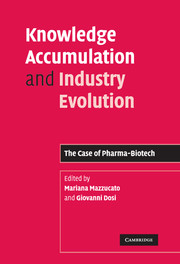Startup Boards: A Field Guide to Building and Leading an Effective Board of Directors
04 de desembre 2022
03 de desembre 2022
The roots of good governance (3)
High Performance Boards: Improving and Energizing your Governance
Contents:
Part I: The Four Pillars of Board Effectiveness 1
Joanne Marker and Board Service 3
Chapter 1 The Four Pillars of Board Effectiveness 9
The First Pillar: People Quality, Focus, and Dedication 11
The Second Pillar: Information Architecture 14
The Third Pillar: Structures and Processes 15
The Fourth Pillar: Group Dynamics and Board Culture 17
Chapter 2 Governance Challenges around the World 20
Scientific Lessons from Natural Selection 22
What is Transformational Leadership? 23
Should We Trust Leaders? 24
The Governance DNA 26
Chapter 3 The Successful Director: Values and Character 28
Duty of Care 30
Duty of Loyalty 32
Integrity: A Key Characteristic of Board Directors 32
Chapter 4 The First Pillar: People Quality, Focus, and Dedication 35
Quality 35
Focus 38
Dedication 41
Chapter 5 The Second Pillar: Information Architecture 45
How Complete is Your Information? 46
Chapter 6 Board Structures and Processes 50
Processes 51
Committee Structure 52
Board Secretary 53
Lead Director or Vice Chair 55
Chapter 7 Group Dynamics and Board Culture 56
Understanding Group Dynamics 57
Coalitions Within a Board Are Inevitable – and they Feed into Politics 60
Boards Fall into Traps 63
Drawing Strength from the Board’s Potential 66
Developing Self-Awareness 67
Board Culture 69
Part II: Board Failures and Challenges 77
Chapter 8 Four Areas of Board Failure 79
Chapter 9 Risks and Ensuring the Right Board Risk-Philosophy 82
Chapter 10 A Board Member’s Practical Guide to Risk Thinking 85
The Physical Health Check: Technical Risks 86
The Mental Health Check: Behaviours 89
The Strategic Risk Check 93
The Governance Risk Check 94
Chapter 11 Elements of Advanced Risk Techniques for Board Members: From Quants to Cyber 97
The Why and How of Quantitative Risk Assessment for Boards 98
Integration of Risks 101
The Outcome of Risk Assessment 102
Cyber Risk 104
Chapter 12 Crisis Management 107
Crisis as a Turning Point 110
There is Work to Be Done In Peaceful Times 111
Communication Principles 111
Another Powerful Weapon: Gathering Information 113
A Crisis Will Shed Light On Boardroom Fissures 115
Procedure vs. Authenticity 117
Communicate Your Way to Rebuilding Trust 118
Chapter 13 The Four Tiers of Conflicts of Interest 120
Tier-I Conflicts: Individual Directors vs. Company 122
Tier-II Conflicts: Directors vs. Stakeholders 124
Tier-III Conflicts: Stakeholders vs. Other Stakeholders 131
Conflicts of Interest within a Group of Stakeholders 135
Tier-IV Conflicts: Company vs. Society 136
Chapter 14 High-Level Fraud and Active Board Oversight 141
Why Does High-Level Fraud Happen? 143
Injustice 147
Lax Oversight 148
Problematic Culture 149
Financial Illiteracy 151
How to Create an Effective Oversight Environment 152
Preventing Injustice: Broaden the Notion of Conflict of Interest 152
Preventing Lax Oversight: Build Appropriate Frameworks 153
Preventing Toxic Behaviours: Create a Positive Culture 156
Strengthen Board Oversight Expertise with Special Focus on Legal, Compliance, Risk, Fraud, and Financial Reporting 159
Tools For Anti-Fraud Activities: Assessment, Prevention, Detection, and Investigation 160
Assessment 161
Prevention 161
Detection 161
Investigation 162
Part III: Board Best Practices 165
Chapter 15 The Board as a Strategic Asset 167
Five Definitions of Strategy 168
Clarifying the Board’s Role 171
Taking Context into the Mapping Process 174
The Impact of Context on Strategic Views and Roles of the Board 175
The Board’s Ultimate Strategic Significance 176
Chapter 16 A Primer on Finance Essentials for Directors 177
Reading Financial Reports 178
Understanding Ratios to Analyse Operating Strategies 179
Interpreting Between the Lines of Financial Statements 181
How to Identify Red Flags in Financial Statements 182
Implementing Desired Capital Structure 184
Understanding Valuation Fundamentals 185
Making Better M&A Decisions 187
Overseeing Risk 189
Joanne Marker and Board Values at Comfre 193
Chapter 17 Board Leadership and Values 197
Quality Boards Live and Breathe Integrity 198
Which and Whose Values? 199
Board Values vs. Organisational Values 202
Family Values in Business 203
Chapter 18 The Intricacies of Subsidiary/Holding Governance 204
Structures 206
Culture 208
Chapter 19 Fostering Entrepreneurship from the Board 210
‘Best Practice’ Governance vs. Entrepreneurship 211
Boards Should Actively Encourage Entrepreneurship 212
Chapter 20 The Board’s Oversight Framework for M&As 217
Creating a Deal-Making Mindset 218
Seeing the Bigger Picture 220
Staging Deals with Maximum Precision 220
Integration 225
Confronting Litigation Involving M&As 226
Joanne Marker Confronts Failing Board Culture 229
Chapter 21 The Chair–CEO Relationship 233
The Role of the Chair 233
Chairs are Increasingly Active 237
Chair–CEO Dynamics – the Hallmarks of a Productive Relationship 238
Tests of the Chair–CEO Relationship 240
The Ideal Attributes of a Chair 242
Chapter 22 The Board–Management Relationship 244
Supervision 244
Support 246
Blurring the Board–Management Relationship 247
Writing Governance Codes is Easier Than Changing Behaviours 248
Chapter 23 Effective Diversity 251
Diversity is Good . . . But Why; and When? 251
Diversity as a Considered Choice 252
Gender 253
Culture 255
Personality 256
Age 257
Social Background 259
We Have Embraced Diversity . . . Now What? 260
The Chair’s Role in Building and Nurturing Diversity 262
Chapter 24 The Talent Pipeline 265
The Board’s Responsibility for Talent Management 265
The New Talent Dynamic: Culture, Values, Community 268
Chapter 25 Boards and Social Media 272
JP Morgan’s Failed Foray into Twitter Q&A 273
Why Boards Should Understand Social Media 274
What Boards Should Do 276
Chapter 26 Boards and Investors 279
The Move toward Increasing Shareholder Engagement 281
Chapter 27 Managing Stakeholders 283
Shareholders vs. Stakeholders: A Definition 284
How to Identify a Company’s Key Stakeholders 285
The Board Can Be Instrumental in Shaping the CEO–Stakeholders Conversation 285
Anticipating Stakeholders’ Influence and Impact 286
Chapter 28 Stewardship from the Board 289
Building Upon a Rich Cross-Disciplinary Legacy of Thought 291
Psychological, Organisational, and Cultural Influences on Stewardship 291
Steward Leaders Build on their Unique Strengths to Drive Stewardship 292
Steward Leaders Deliver Long-Lasting, Meaningful, and Inclusive Impact 293
Becoming a Steward Leader: What it Takes 295
Stewardship Risks 297
Boards Are Key to Fostering Stewardship 297
Conclusion 299
02 de desembre 2022
The roots of good governance (2)
Contents:
1 The Handbook of Board Governance: An Introduction and Overview 1
Richard Leblanc
I The Board’s First Responsibility: The Right CEO 43
2 CEO Succession Planning Trends and Forecast 45
Gary Larkin
3 CEO Succession Planning 58
David F. Larcker and Brian Tayan
4 CEO Succession: Lessons from the Trenches for Directors 77
Mark B. Nadler
Appendix 1 Model CEO Succession Planning Charter 98
Richard Leblanc
Appendix 2 Model CEO Position Description 105
Richard Leblanc
II The Board’s Second Responsibility: The Right Board Chair 111
5 The Nonexecutive Chairman: Toward a Shareholder Value Maximization Role 113
Henry D. Wolfe
6 Great Boards Don’t Exist Without Great Chairs 148
Elizabeth Watson and Heather Kelsall
7 What’s in a Name? The Lead Director Role at U.S. Public Companies 164
Richard Fields and Anthony Goodman
Appendix 3 Model Board Chair Position Description 192
Richard Leblanc
III Who is at the Board Table? Board Composition, Dynamics, and Decision-Making 197
8 Director Independence, Competency, and Behavior 199
Richard Leblanc
9 Board Behaviors: How Women Directors Influence Decision Outcomes 233
Dr. Mary Halton
10 The State of Gender Diversity in Boardrooms 253
Dr. Nancy Gianni Herbert
11 Every Seat Matters 269
Annie Tobias and Lina Pallotta
12 The Art of Asking Questions as a Director 283
J. Lyn McDonell
13 Board Succession, Evaluation, and Recruitment: A Global Perspective 301
Jakob Stengel
Appendix 4 Model Individual Director Position Description 319
Richard Leblanc
Appendix 5 Model Conflict of Interest Policy for Directors 323
Richard Leblanc
IV The Work of the Board 333
A. Climate governance 333
14 Climate Change and Directors’ Duties: Closing the Gap Between Legal Obligation and Enforcement Practice 335
Ellie Mulholland, Sarah Barker, Cynthia Williams, and Robert G. Eccles
15 Board Oversight and Climate Change: What Directors Need to Know 369
Patricia A. Koval
16 Responsible Boards for a Sustainable Future 398
Dr. Yilmaz Argüden
17 Corporate Governance to Advance Business and Society 434
Alice Korngold
B. Technology Governance 467
18 Technology and the Corporate Board 2020 and Beyond 469
Dr. Gary L. Evans
19 Responsive Governance in a Digital World: The Need to Up-Skill 492
Dr. Elizabeth Valentine, Dr. Steven De Haes, and Dr. Anant Joshi
20 The Impact of Blockchain Technology for Corporate Governance 526
Jack J. Bensimon
21 Blockchain: An Introduction for Boards of Directors 556
Dr. Elizabeth Valentine, Dr. Greg Timbrell, Lachlan Feeney, and Dr. John Puttick
22 Reflections of a Board Chair on the Christchurch Massacre: Governing Social Media 578
Drew Stein
C. Risk and Financial Governance 595
23 Financial Literacy and Audit Committees: A Primer for Directors and Audit Committee Members 597
Jason Masters
24 Corporate Governance in an Age of Populism 624
John Zinkin
25 A Call to Action for Geopolitical Governance 641
Sean West and Rohitesh Dhawan
26 Governing Boards, Risk Management, and Deliberative Thinking 655
Michael Useem
27 Lawyers’ Advice to Directors on Overseeing Executive Pay 672
Howard Levitt and Allyson Lee
28 Accountant’s Advice to Company Directors: Directors’ Obligations to Detect Top-10 Frauds 687
Dr. L. S. (Al) Rosen
29 Ten Tell-Tale Signs ofPossible Fraud: A Director’s Primer 704
James Hunter
30 100 Questions Directors Should Ask When Assessing the Effectiveness of Risk Systems 713
F. Edward “Ted” Price
31 Risk Oversight for Directors: A Practical Guide 719
Stephen J. Mallory
32 Risk Governance: Leading Practice and Demographic Impacts 739
Ingrid Robinson
D. Strategic Governance 759
33 Agile Governance 761
Scott Koerwer and Joseph Perfetti
34 The Three Dilemmas for Creating a Long-Term Board 786
Ariel Fromer Babcock, Robert G. Eccles, and Sarah Keohane Williamson
35 Strategic Blindspots in the Boardroom 815
Estelle Métayer
E. Human Capital and Compensation Governance 839
36 Winter is Coming: The Approaching Human Capital Management Storm 841
Solange Charas and Michael Young
37 The Effective Compensation Committee 861
Steven Hall and Steven Hall Jr
38 Compensation Governance and Performance-Based Executive Compensation 889
Paul Gryglewicz
39 Measuring and Improving Pay for Performance: Board Oversight of Executive Pay 906
Stephen F. O’Byrne
40 Designing Performance for Long-Term Value: Aligning Business Strategy, Management Structure, and Incentive Design 930
Mark Van Clieaf
41 Mind the Gap: How Human Resources Can Become More Integral to the Corporate Boardroom Agenda 953
Jay A. Conger and Edward E. Lawler III
F. Legal and Governance Responsibilities of Directors 967
42 Board Risk and Responsibility Under Regulatory and Criminal Law 969
Norm Keith
43 Riding Between Cars: The Position of the Corporate Secretary 987
Douglas K. Chia
44 Ensuring Good Governance and Business Success in International Subsidiaries 1004
Thomas C. Sears
V Shareholder Engagement and Board Accountability 1021
45 The Rise of Investor Stewardship 1023
Stephen Davis
46 Director/Shareholder Meetings 1049
Stephen Erlichman
47 Dual-Class Share Firms in Developed Market Economies 1066
Anita I. Anand
48 For Directors: The Long-Term Relationship Between Directors, Companies, and Institutional Investors 1088
Carol Nolan Drake
49 Proxy Scorecards Will Empower Investors 1111
James McRitchie
VI Not-For-Profit Governance 1127
50 Charitable and Not-for-Profit Organization Governance 1129
Donald J. Bourgeois
51 The Best of Boards, the Worst of Boards: The Not-for-Profit Experience 1145
Adam Quinton
52 Fundraising Best Practices for Not-for-Profit Boards of Directors 1164
Stephanie Cory
VII Small and Medium Company Governance 1179
53 Governance of Small and Medium-Sized Entities 1181
Jo Iwasaki
54 Private Versus Public Company Governance: Top-13 Questions for Board Members to Consider 1197
Carol Nolan Drake and Sally J. Curley
55 Cannabis Governance: Advice for Current and Prospective Directors in This Emerging Industry 1220
Steve Chan
VIII Global Corporate Governance 1229
56 Cross-Border Corporate Governance 1231
Hari Panday
57 Corporate Governance in Asia-Pacific 1260
John Zinkin
58 Boards of Directors of Chinese Companies 1287
David H. Zhu, Wei’An Li, and Yaowei Zhang
59 The Russian Corporate Governance Story 1316
Alexander A. Filatov
60 CARICOM (Caribbean Community) Governance 1333
Ronaele Dathorne-Bayrd
61 King IV: Taking Corporate Governance to the Next Level 1343
Parmi Natesan and Dr. Prieur Du Plessis
01 de desembre 2022
How to fix current public problems?
Solving Public Problems. A Practical Guide to Fix Our Government and Change Our World
A radical rethinking of the role of the public servant and the skills of the public workforce, this book is about the vast gap between failing public institutions and the huge number of public entrepreneurs doing extraordinary things—and how to close that gap.
27 de novembre 2022
26 de novembre 2022
Pharma and Medtech market access
Commercializing Successful Biomedical Technologies
Contents
1 - The biomedical drug, diagnostic, and devices industries and their marketspp 1-35
2 - Markets of interest and market research stepspp 36-62
3 - Intellectual property, licensing, and business modelspp 63-103
4 - New product development (NPD)pp 104-171
5 - The regulated market: gateway through the FDApp 172-225
6 - Manufacturingpp 226-263
7 - Reimbursement, marketing, sales, and product liabilitypp 264-316
25 de novembre 2022
Wellbeing as a top priority
Why not focus directly on increasing measured human happiness? Why not try to improve people’s overall quality of life, as it is subjectively seen by citizens themselves?
Contents:
Introduction: Making Wellbeing Policies Effective
Timothy Besley & Irene Bucelli
Wellbeing as the Goal of Policy
Richard Layard
Accounting for Consequences and Claims in Policy
Paul Dolan
Weighing the Costs and Benefits of Public Policy: On the Dangers of Single Metric Accounting
Johanna Thoma
Wellbeing in Public Policy: Contributions Based on Sen’s Capability Approach
Paul Anand
Incorporating Wellbeing and Mental Health Research to Improve Pandemic Response
Michael Daly & Liam Delaney
COVID-19 and Mental Health and Wellbeing Research: Informing Targeted, Integrated, and Long-Term Responses to Health Emergencies
Annette Bauer
Health, Wellbeing, and Democratic Citizenship: A Review and Research Agenda
Christopher J. Anderson et al.
Health and Disability Gaps in Political Engagement: A Short Review
Mikko Mattila
24 de novembre 2022
Pharma competition and innovation
My speech at the Reial Acadèmia de Medicina de Catalunya, 22/11/2022:
23 de novembre 2022
Reframing the human body as a cellular ecosystem
The Song of the Cell. An Exploration of Medicine and the New Human
In The Song of the Cell, Mukherjee tells the story of how scientists discovered cells, began to understand them, and are now using that knowledge to create new humans. He seduces you with writing so vivid, lucid, and suspenseful that complex science becomes thrilling. Told in six parts, laced with Mukherjee’s own experience as a researcher, a doctor, and a prolific reader, The Song of the Cell is both panoramic and intimate—a masterpiece.
A must read!!!
21 de novembre 2022
19 de novembre 2022
18 de novembre 2022
17 de novembre 2022
Personalized, stratified or precision medicine: the expectations behind a concept
Contested futures: envisioning “Personalized,” “Stratified,” and “Precision” medicine
Rather than pinpointing which of these terms is the “correct” one or delineating the “true” meaning of each, to know how we should critically approach the concepts we need an awareness of the discursive contexts in which they are mobilized. This is because the context ultimately structures the social and ethical implications that “personalization,” “stratification,” or “precision” will have for medicine and healthcare systems, and for different stakeholders. As big health data, predictive and systems-level analysis are, themselves, emergent phenomena, the terminology applied in the discursive spaces around these new biotechnologies and approaches cannot be abstracted from their context. Rather, when we apply the “personalization,” “stratification,” and “precision” terms, we invoke particular associations, connotations, “hopes” and “truths” that are part of pre-existing epistemologically and ethically loaded discourses that reflect broader and weightier struggles over what is a good future.
16 de novembre 2022
Pharma, big pharma (18)
Knowledge Accumulation and Industry Evolution
This book explores how the biotechnology and pharmaceutical sector is affected by innovation, growth and public policy.
